Impact of Desert Dust on Air Quality: What is the Meaningfulness of Daily PM Standards in Regions Close to the Sources? The Example of Southern Tunisia
Abstract
:1. Introduction
2. Materials and Methods
2.1. Location of the Station
2.2. Instruments and Method
2.2.1. PM10 Concentration
2.2.2. Sunphotometric Measurements
2.2.3. Data Selection
3. Results and Discussion
3.1. Tunisian Air Quality Standards
3.1.1. Annual Mean PM10 Concentrations
3.1.2. Daily Mean PM10 Concentrations
3.2. The Situations of the Excess of the Tunisian Daily Air Quality Standards
3.2.1. Nature of the Aerosol
3.2.2. Sub-Daily Variability
4. Conclusions
Author Contributions
Funding
Acknowledgments
Conflicts of Interest
Appendix A
| TEOM™ (%) | Photometer (Number of Days) | |
|---|---|---|
| February 2014 | 99 | ND |
| March 2014 | 100 | ND |
| April 2014 | 100 | ND |
| May 2014 | 100 | ND |
| June 2014 | 100 | ND |
| July 2014 | 99 | 4 |
| August 2014 | 77 | 31 |
| September 2014 | 100 | 29 |
| October 2014 | 94 | 30 |
| November 2014 | 100 | 27 |
| December 2014 | 98 | 9 |
| January 2015 | 100 | 24 |
| February 2015 | 100 | 20 |
| March 2015 | 100 | ND |
| April 2015 | 99 | ND |
| May 2015 | 89 | 26 |
| June 2015 | 94 | 30 |
| July 2015 | 99 | 31 |
| August 2015 | 100 | 28 |
| September 2015 | 88 | 21 |
| October 2015 | 17 | 26 |
| November 2015 | 100 | 25 |
| December 2015 | 99 | 30 |
| January 2016 | 98 | 23 |
| February 2016 | 99 | 25 |
| March 2016 | 99 | 29 |
| April 2016 | 65 | 29 |
| May 2016 | 99 | 26 |
| June 2016 | 99 | 16 |
| July 2016 | 99 | 31 |
| August 2016 | 99 | 31 |
| September 2016 | 97 | 29 |
| October 2016 | 99 | 31 |
| November 2016 | 99 | 22 |
| December 2016 | 100 | 27 |
| January 2017 | 100 | 29 |
| February 2017 | 100 | 28 |
| March 2017 | 99 | 27 |
| April 2017 | 99 | 23 |
| May 2017 | 99 | 30 |
| June 2017 | 97 | 29 |
| July 2017 | 82 | 30 |
| August 2017 | 99 | 31 |
| September 2017 | 99 | 29 |
| October 2017 | 100 | 28 |
| November 2017 | 89 | 12 |
| December 2017 | 99 | 26 |
| January 2018 | 100 | 27 |
| February 2018 | 99 | 20 |
| March 2018 | 100 | 28 |
| April 2018 | 99 | 28 |
| May 2018 | 99 | 29 |
| June 2018 | 99 | 29 |
| July 2018 | 90 | 31 |
| August 2018 | 100 | 30 |
| September 2018 | 99 | 26 |
| October 2018 | 99 | 16 |
| November 2018 | 99 | 27 |
| December 2018 | 100 | 31 |
| January 2019 | 99 | 27 |
| February 2019 | 100 | 18 |
Appendix B
| Region | Country | City | Type of Station | Year | Source |
|---|---|---|---|---|---|
| South Europe | Spain | Montseny | Regional Background | 2002–2011 mean value | Pey et al. [45] |
| South Europe | Spain | Monagrega | Regional Background | 2001–2011 mean value | Pey et al. [45] |
| South Europe | Spain | Zarra | Regional Background | 2001–2011 mean value | Pey et al. [45] |
| South Europe | Spain | Víznar | Regional Background | 2001–2011 mean value | Pey et al. [45] |
| South Europe | Spain | Barcarrota | Regional Background | 2001–2011 mean value | Pey et al. [45] |
| South Europe | Spain | San Pablo de los Montes | Regional Background | 2001–2011 mean value | Pey et al. [45] |
| South Europe | Spain | Castillo de Bellver | Sub-urban regional | 2001–2011 mean value | Pey et al. [45] |
| South Europe | France | Genas | Regional Background | 2001–2010 mean value | Pey et al. [45] |
| South Europe | France | Drôme Rurale Sud | Regional Background | 2004–2010 mean value | Pey et al. [45] |
| South Europe | Italy | Febbio | Regional Background | 2005–2010 mean value | Pey et al. [45] |
| South Europe | Italy | Fontechiari | Regional Background | 2001–2010 mean value | Pey et al. [45] |
| South Europe | Italy | Lecce | Regional Background | 2009–2010 mean value | Pey et al. [45] |
| South Europe | Italy | Censt | Regional Background | 2005–2010 mean value | Pey et al. [45] |
| South Europe | Italy | Boccadifalco | Sub-urban regional | 2001–2010 mean value | Pey et al. [45] |
| South Europe | Greece | Panorama | Sub-urban regional | 2001–2010 mean value | Pey et al. [45] |
| South Europe | Greece | Agia Pareskevi | Sub-urban regional | 2001–2010 mean value | Pey et al. [45] |
| South Europe | Greece | Finokalia | Regional Background | 2004–2010 mean value | Pey et al. [45] |
| South Europe | Bulgaria | Rojen Peak | Regional Background | 2005–2010 mean value | Pey et al. [45] |
| South Europe | Cyprus | Ayia Marina | Regional Background | 2003–2010 mean value | Pey et al. [45] |
| North Africa | Tunisia | El Fjé | Rural | 2014–2018 mean value | This work |
| North Africa | Tunisia | Bizerte | Urban residential/traffic/commercial | 2010 | WHO GUAAP Database (2016) * |
| North Africa | Tunisia | Sfax | Urban | 2010 | WHO GUAAP Database (2016) |
| North Africa | Tunisia | Sousse | Urban residential/traffic/commercial | 2010 | WHO GUAAP Database (2016) |
| North Africa | Tunisia | Tunis | Urban | 2010 | WHO GUAAP Database (2016) |
| North Africa | Morocco | Casablanca | 4 stations, urban background station | 2013 | WHO GUAAP Database (2016) |
| North Africa | Morocco | Fès | Urban background station | 2013 | WHO GUAAP Database (2016) |
| North Africa | Morocco | Marrakech | 2 stations, urban background station | 2012 | WHO GUAAP Database (2016) |
| North Africa | Morocco | Meknes | Urban | 2008 | WHO GUAAP Database (2016) |
| North Africa | Morocco | Safi | Urban background station | 2011 | WHO GUAAP Database (2016) |
| North Africa | Morocco | Salé | Urban background station | 2011 | WHO GUAAP Database (2016) |
| North Africa | Morocco | Tanger | Urban background station | 2013 | WHO GUAAP Database (2016) |
| North Africa | Egypt | Delta region | 14 stations | 2013 | WHO GUAAP Database (2016) |
| North Africa | Egypt | Greater Cairo | 47 stations | 2013 | WHO GUAAP Database (2016) |
| West Africa | Liberia | Buchanan | Rural, 500m away from community, Osris | 2009 | WHO GUAAP Database (2016) |
| West Africa | Liberia | Sanniquellie | Rural, within the community, Osiris monitors | 2009 | WHO GUAAP Database (2016) |
| West Africa | Nigeria | Aba | NA | 2009 | WHO GUAAP Database (2016) |
| West Africa | Nigeria | Abakaliki | NA | 2009 | WHO GUAAP Database (2016) |
| West Africa | Nigeria | Afikpo | NA | 2009 | WHO GUAAP Database (2016) |
| West Africa | Nigeria | Enugu | NA | 2009 | WHO GUAAP Database (2016) |
| West Africa | Nigeria | Ile-Ife | University campus | 2010 | WHO GUAAP Database (2016) |
| West Africa | Nigeria | Nnewi | NA | 2009 | WHO GUAAP Database (2016) |
| West Africa | Nigeria | Nsukka | NA | 2009 | WHO GUAAP Database (2016) |
| West Africa | Nigeria | Onitsha | NA | 2009 | WHO GUAAP Database (2016) |
| West Africa | Nigeria | Orlu | NA | 2009 | WHO GUAAP Database (2016) |
| West Africa | Nigeria | Owerri | NA | 2009 | WHO GUAAP Database (2016) |
| West Africa | Nigeria | Umuahia | NA | 2009 | WHO GUAAP Database (2016) |
| West Africa | Senegal | Dakar | 4 stations, traffic, urban, industrial | 2013 | WHO GUAAP Database (2016) |
| West Africa | Senegal | M’Bour | Coastal/urban | 2006–2010 mean value | Kaly et al. [46] |
| West Africa | Mali | Cinzana | Rural | 2006–2010 mean value | Kaly et al. [46] |
| West Africa | Niger | Banizoumbou | Rural | 2006–2010 mean value | Kaly et al. [46] |
Appendix C
| Month | Nobs. | > 120 µg m−3 | > 260 µg m−3 |
|---|---|---|---|
| February 2014 | 17 | 3 | 2 |
| March 2014 | 31 | 6 | 3 |
| April 2014 | 30 | 4 | 2 |
| May 2014 | 31 | 1 | 0 |
| June 2014 | 29 | 1 | 0 |
| July 2014 | 31 | 0 | 0 |
| August 2014 | 25 | 0 | 0 |
| September 2014 | 30 | 4 | 0 |
| October 2014 | 30 | 1 | 1 |
| November 2014 | 30 | 4 | 2 |
| December 2014 | 31 | 5 | 2 |
| January 2015 | 31 | 4 | 2 |
| February 2015 | 28 | 6 | 2 |
| March 2015 | 31 | 5 | 0 |
| April 2015 | 30 | 0 | 0 |
| May 2015 | 29 | 1 | 0 |
| June 2015 | 29 | 2 | 2 |
| Juny 2015 | 31 | 0 | 0 |
| August 2015 | 31 | 1 | 0 |
| September 2015 | 27 | 1 | 0 |
| October 2015 | 5 | 0 | 0 |
| November 2015 | 30 | 0 | 0 |
| December 2015 | 31 | 0 | 0 |
| January 2016 | 31 | 1 | 1 |
| February 2016 | 29 | 5 | 0 |
| March 2016 | 31 | 3 | 2 |
| April 2016 | 22 | 2 | 1 |
| May 2016 | 31 | 3 | 1 |
| June 2016 | 30 | 2 | 1 |
| July 2016 | 31 | 1 | 0 |
| August 2016 | 31 | 0 | 0 |
| September 2016 | 30 | 1 | 0 |
| October 2016 | 31 | 1 | 1 |
| November 2016 | 30 | 3 | 1 |
| December 2016 | 31 | 1 | 1 |
| January 2017 | 31 | 1 | 0 |
| February 2017 | 28 | 3 | 1 |
| March 2017 | 31 | 0 | 0 |
| April 2017 | 30 | 2 | 1 |
| May 2017 | 31 | 2 | 2 |
| June 2017 | 30 | 0 | 0 |
| July 2017 | 28 | 0 | 0 |
| August 2017 | 31 | 0 | 0 |
| September 2017 | 30 | 1 | 1 |
| October 2017 | 31 | 0 | 0 |
| November 2017 | 30 | 0 | 0 |
| December 2017 | 31 | 0 | 0 |
| January 2018 | 31 | 1 | 0 |
| February 2018 | 28 | 1 | 0 |
| March 2018 | 31 | 10 | 4 |
| April 2018 | 30 | 6 | 2 |
| May 2018 | 31 | 3 | 1 |
| June 2018 | 30 | 0 | 0 |
| July 2018 | 29 | 0 | 0 |
| August 2018 | 31 | 0 | 0 |
| September 2018 | 30 | 0 | 0 |
| October 2018 | 31 | 2 | 1 |
| November 2018 | 30 | 0 | 0 |
| December 2018 | 31 | 1 | 0 |
| January 2019 | 31 | 1 | 0 |
| February 2019 | 28 | 1 | 0 |
Appendix D. Detailed Analysis of the 12 February and 13 May 2014 Dust Events


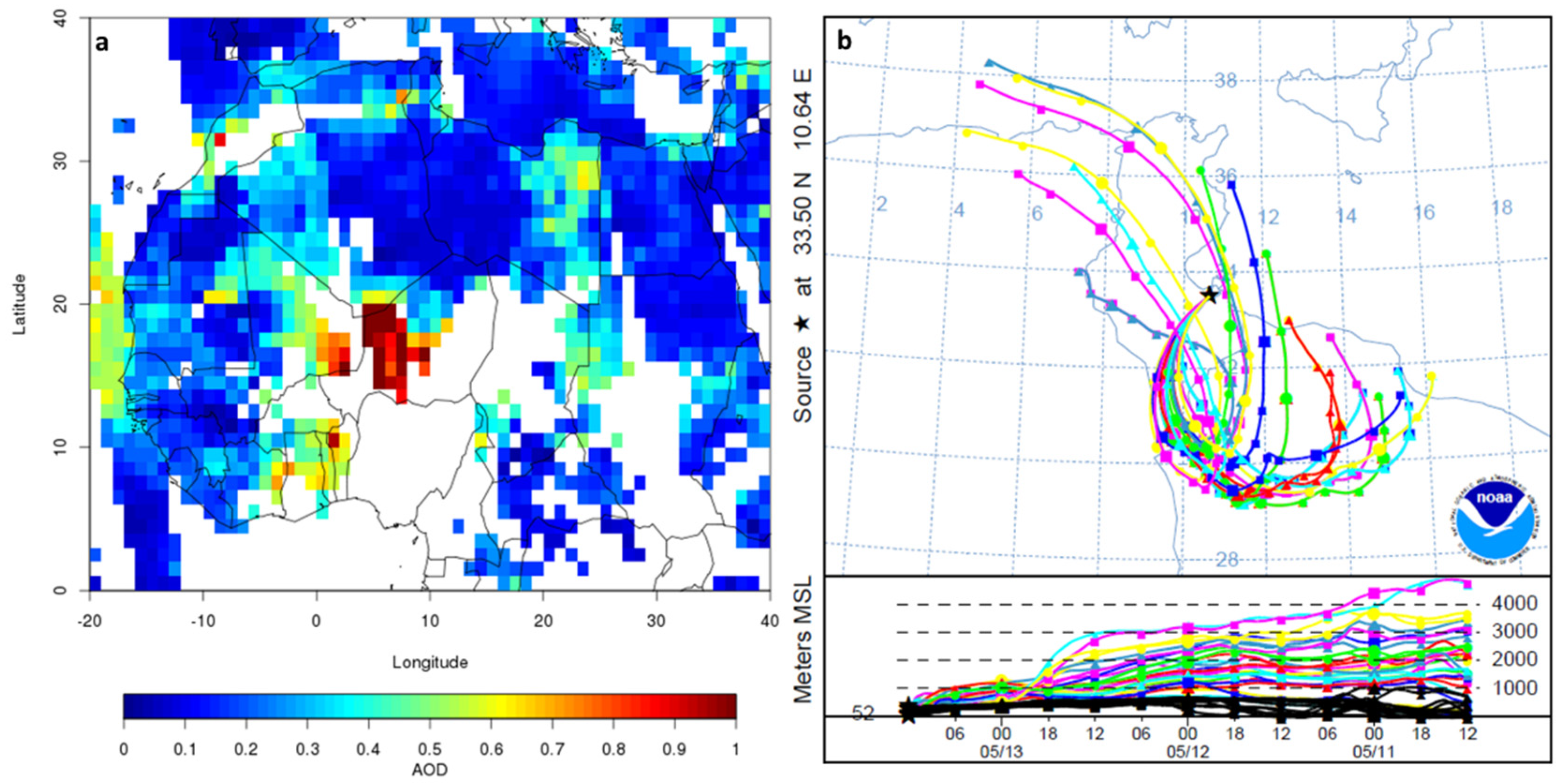
References
- Brunekreef, B.; Holgate, S.T. Air pollution and health. Lancet 2002, 360, 1233–1242. [Google Scholar] [CrossRef]
- Brunekreef, B.; Forsberg, B. Epidemiological evidence of effects of coarse airborne particles on health. Eur. Respir. J. 2005, 26, 309–318. [Google Scholar] [CrossRef] [PubMed]
- Heyder, J. Single particle deposition in human airways. In Physical and Chemical Characterization of Individual Airborne Particles; Spurny, K.R., Ed.; Ellis Horwood: Chichester, UK, 1986; pp. 77–85. [Google Scholar]
- Annesi-Maesano, I.; Forastiere, F.; Kunzli, N.; Brunekref, B.; Environment and Health Committee of the European Respiratory Society. Particulate matter, science and EU policy. Eur. Respir. J. 2007, 29, 428–431. [Google Scholar] [CrossRef] [PubMed] [Green Version]
- Pope, C.A. Cardiovascular Mortality and Long-Term Exposure to Particulate Air Pollution: Epidemiological Evidence of General Pathophysiological Pathways of Disease. Circulation 2003, 109, 71–77. [Google Scholar] [CrossRef]
- Schwartz, J. Air Pollution and Daily Mortality: A Review and Meta Analysis. Environ. Res. 1994, 64, 36–52. [Google Scholar] [CrossRef] [PubMed]
- World Health Organization Review of Evidence on Health Aspects of Air Pollution—REVIHAAP Project; World Health Organization: Copenhagen, Denmark, 2013.
- Climate Change 2013: The Physical Science Basis. Contribution of Working Group I to the Fifth Assessment Report of the Intergovernmental Panel on Climate Change; Stocker, T.F.; Qin, D.; Plattner, G.-K.; Tignor, M.; Allen, S.K.; Boschung, J.; Nauels, A.; Xia, Y.; Bex, V.; Midgley, P.M. (Eds.) Cambridge University Press: Cambridge, UK; New York, NY, USA, 2014; ISBN 978-1-107-05799-9. [Google Scholar]
- Middleton, N.J. Desert dust hazards: A global review. Aeolian Res. 2017, 24, 53–63. [Google Scholar] [CrossRef]
- De Longueville, F.; Ozer, P.; Doumbia, S.; Henry, S. Desert dust impacts on human health: An alarming worldwide reality and a need for studies in West Africa. Int. J. Biometeorol. 2013, 57, 1–19. [Google Scholar] [CrossRef]
- Goudie, A.S. Desert dust and human health disorders. Environ. Int. 2014, 63, 101–113. [Google Scholar] [CrossRef]
- Hashizume, M.; Ueda, K.; Nishiwaki, Y.; Michikawa, T.; Onozuka, D. Health effects of Asian dust events: A review of the literature. Jpn. J. Hyg. 2010, 65, 413–421. [Google Scholar] [CrossRef]
- Karanasiou, A.; Moreno, N.; Moreno, T.; Viana, M.; de Leeuw, F.; Querol, X. Health effects from Sahara dust episodes in Europe: Literature review and research gaps. Environ. Int. 2012, 47, 107–114. [Google Scholar] [CrossRef]
- Kwon, H.-J. Toxicity and health effects of Asian dust: A literature review. J. Korean Med. Assoc. 2012, 55, 234. [Google Scholar] [CrossRef]
- Morman, S.A.; Plumlee, G.S. The role of airborne mineral dusts in human disease. Aeolian Res. 2013, 9, 203–212. [Google Scholar] [CrossRef]
- Venero-Fernández, S.J. Saharan Dust Effects on Human Health: A Challenge for Cuba’s Researchers. MEDICC Rev. 2016, 18, 32–34. [Google Scholar] [PubMed]
- Zhang, X.; Zhao, L.; Tong, D.; Wu, G.; Dan, M.; Teng, B. A systematic review of global desert dust and associated human health effects. Atmosphere 2016, 7, 158. [Google Scholar] [CrossRef]
- Pauley, P.M.; Baker, N.L.; Barker, E.H. An observational Study of the “Interstate 5” Dust Storm Case. Bull. Am. Meteorol. Soc. 1996, 77, 693–720. [Google Scholar] [CrossRef]
- Giannadaki, D.; Pozzer, A.; Lelieveld, J. Modeled global effects of airborne desert dust on air quality and premature mortality. Atmos. Chem. Phys. 2014, 14, 957–968. [Google Scholar] [CrossRef] [Green Version]
- Evans, J.; van Donkelaar, A.; Martin, R.V.; Burnett, R.; Rainham, D.G.; Birkett, N.J.; Krewski, D. Estimates of global mortality attributable to particulate air pollution using satellite imagery. Environ. Res. 2013, 120, 33–42. [Google Scholar] [CrossRef]
- De Longueville, F.; Hountondji, Y.-C.; Henry, S.; Ozer, P. What do we know about effects of desert dust on air quality and human health in West Africa compared to other regions? Sci. Total Environ. 2010, 409, 1–8. [Google Scholar] [CrossRef] [Green Version]
- Baldasano, J.M.; Valera, E.; Jiménez, P. Air quality data from large cities. Sci. Total Environ. 2003, 307, 141–165. [Google Scholar] [CrossRef]
- Mathers, C.D.; Ma Fat, D.; Inoue, M.; Rao, C.; Lopez, A.D. Counting the dead and what they died from: An assessment of the global status of cause of death data. Bull. World Health Organ. 2005, 83, 171–177c. [Google Scholar]
- INS. Résultats du Recensement 2014 par Gouvernorats et Délégations; INS: Tunis, Tunisia, 2014; Volume 2. [Google Scholar]
- Akrimi, N.; Kardous, M.; Taamallah, H. Mouvements de sable en relation avec la nature et la vitesse de certains outils de travail du sol en zones arides (étude d’un cas pratique). Revue des Régions Arides 1993, 5, 35–57. [Google Scholar]
- Bergametti, G.; Gomes, L.; Remoudaki, E.; Desbois, M.; Martin, D.; Buat-Ménard, P. Present transport and deposition patterns of African dusts to the north-western Mediterranean. In Paleoclimatology and Paleometeorology: Modern and Past Patterns of Global Atmospheric Transport; NATO Science Series C; Springer Netherlands: Heidelberg, Germany, 1989; Volume 282, pp. 227–252. [Google Scholar]
- Guerzoni, S.; Molinaroli, E.; Chester, R. Saharan dust inputs to the western Mediterranean Sea: Depositional patterns, geochemistry and sedimentological implications. Deep Sea Res. Part II Top. Stud. Oceanogr. 1997, 44, 631–654. [Google Scholar] [CrossRef]
- Israelevich, P.; Ganor, E.; Alpert, P.; Kishcha, P.; Stupp, A. Predominant transport paths of Saharan dust over the Mediterranean Sea to Europe. J. Geophys. Res. Atmos. 2012, 117, D02205. [Google Scholar] [CrossRef]
- Marconi, M.; Sferlazzo, D.M.; Becagli, S.; Bommarito, C.; Calzolai, G.; Chiari, M.; di Sarra, A.; Ghedini, C.; Gómez-Amo, J.L.; Lucarelli, F.; et al. Saharan dust aerosol over the central Mediterranean Sea: PM10 chemical composition and concentration versus optical columnar measurements. Atmos. Chem. Phys. 2014, 14, 2039–2054. [Google Scholar] [CrossRef] [Green Version]
- Meloni, D.; di Sarra, A.; Monteleone, F.; Pace, G.; Piacentino, S.; Sferlazzo, D.M. Seasonal transport patterns of intense Saharan dust events at the Mediterranean island of Lampedusa. Atmos. Res. 2008, 88, 134–148. [Google Scholar] [CrossRef]
- Moulin, C.; Lambert, C.E.; Dayan, U.; Masson, V.; Ramonet, M.; Bousquet, P.; Legrand, M.; Balkanski, Y.J.; Guelle, W.; Marticorena, B.; et al. Satellite climatology of African dust transport in the Mediterranean atmosphere. J. Geophys. Res. Atmos. 1998, 103, 13137–13144. [Google Scholar] [CrossRef]
- Schepanski, K.; Mallet, M.; Heinold, B.; Ulrich, M. North African dust transport toward the western Mediterranean basin: Atmospheric controls on dust source activation and transport pathways during June–July 2013. Atmos. Chem. Phys. 2016, 16, 14147–14168. [Google Scholar] [CrossRef]
- Vincent, J.; Laurent, B.; Losno, R.; Bon Nguyen, E.; Roullet, P.; Sauvage, S.; Chevaillier, S.; Coddeville, P.; Ouboulmane, N.; di Sarra, A.G.; et al. Variability of mineral dust deposition in the western Mediterranean basin and south-east of France. Atmos. Chem. Phys. 2016, 16, 8749–8766. [Google Scholar] [CrossRef] [Green Version]
- Dahech, S.; Beltrando, G. Le vent de sable dans le Sud tunisien: Conséquences pour l’homme à Sfax. La Météorologie 2012, 79, 40–50. [Google Scholar] [CrossRef]
- Bouchlaghem, K.; Nsom, B.; Latrache, N.; Haj Kacem, H. Impact of Saharan dust on PM10 concentration in the Mediterranean Tunisian coasts. Atmos. Res. 2009, 92, 531–539. [Google Scholar] [CrossRef]
- Bouchlaghem, K.; Nsom, B. Effect of atmospheric pollutants on the air quality in Tunisia. Sci. World J. 2012, 2012, 863528. [Google Scholar] [CrossRef] [PubMed]
- World Health Organization. WHO Air Quality Guidelines for Particulate Matter, Ozone, Nitrogen Dioxide and Sulfur Dioxide—Global Update 2005—Summary of Risk Assessment; World Health Organization: Geneva, Switzerland, 2006. [Google Scholar]
- Kallel, M.R. Hydrologie de la Jeffara Tunisienne; DG-RE: Tunis, Tunisia, 2001; p. 65. [Google Scholar]
- Marticorena, B.; Chatenet, B.; Rajot, J.L.; Traoré, S.; Coulibaly, M.; Diallo, A.; Koné, I.; Maman, A.; NDiaye, T.; Zakou, A. Temporal variability of mineral dust concentrations over West Africa: Analyses of a pluriannual monitoring from the AMMA Sahelian Dust Transect. Atmos. Chem. Phys. 2010, 10, 8899–8915. [Google Scholar] [CrossRef]
- Green, D.C.; Fuller, G.W.; Baker, T. Development and validation of the volatile correction model for PM10—An empirical method for adjusting TEOM measurements for their loss of volatile particulate matter. Atmos. Environ. 2009, 43, 2132–2141. [Google Scholar] [CrossRef]
- Grover, B.D.; Kleinman, M.; Eatough, N.L.; Eatough, D.J.; Hopke, P.K.; Long, R.W.; Wilson, W.E.; Meyer, M.B.; Ambs, J.L. Measurement of total PM2.5 mass (nonvolatile plus semivolatile) with the Filter Dynamic Measurement System tapered element oscillating microbalance monitor. J. Geophys. Res. 2005, 110, D07S03. [Google Scholar] [CrossRef]
- Holben, B.N.; Eck, T.F.; Slutsker, I.; Tanré, D.; Buis, J.P.; Setzer, A.; Vermote, E.; Reagan, J.A.; Kaufman, Y.J.; Nakajima, T.; et al. AERONET—A federated instrument network and data archive for aerosol characterization. Remote Sens. Environ. 1998, 66, 1–16. [Google Scholar] [CrossRef]
- Dubovik, O.; Smirnov, A.; Holben, B.N.; King, M.D.; Kaufman, Y.J.; Eck, T.F.; Slutsker, I. Accuracy assessments of aerosol optical properties retrieved from Aerosol Robotic Network (AERONET) Sun and sky radiance measurements. J. Geophys. Res. 2000, 105, 9791–9806. [Google Scholar] [CrossRef] [Green Version]
- Dubovik, O.; King, M.D. A flexible inversion algorithm for retrieval of aerosol optical properties from Sun and sky radiance measurements. J. Geophys. Res. 2000, 105, 20673–20696. [Google Scholar] [CrossRef] [Green Version]
- Pey, J.; Querol, X.; Alastuey, A.; Forastiere, F.; Stafoggia, M. African dust outbreaks over the Mediterranean Basin during 2001–2011: PM10 concentrations, phenomenology and trends, and its relation with synoptic and mesoscale meteorology. Atmos. Chem. Phys. 2013, 13, 1395–1410. [Google Scholar] [CrossRef]
- Kaly, F.; Marticorena, B.; Chatenet, B.; Rajot, J.L.; Janicot, S.; Niang, A.; Yahi, H.; Thiria, S.; Maman, A.; Zakou, A.; et al. Variability of mineral dust concentrations over West Africa monitored by the Sahelian Dust Transect. Atmos. Res. 2015, 164–165, 226–241. [Google Scholar] [CrossRef]
- Alpert, P.; Neeman, B.U.; Shay-El, Y. Climatological analysis of Mediterranean cyclones using ECMWF data. Tellus A 1990, 42, 65–77. [Google Scholar] [CrossRef] [Green Version]
- Dayan, U.; Heffter, J.; Miller, J.; Gutman, G. Dust Intrusion Events into the Mediterranean Basin. J. Appl. Meteor. 1991, 30, 1185–1199. [Google Scholar] [CrossRef] [Green Version]
- Fiedler, S.; Schepanski, K.; Knippertz, P.; Heinold, B.; Tegen, I. How important are atmospheric depressions and mobile cyclones for emitting mineral dust aerosol in North Africa? Atmos. Chem. Phys. 2014, 14, 8983–9000. [Google Scholar] [CrossRef] [Green Version]
- Holben, B.N.; Tanré, D.; Smirnov, A.; Eck, T.F.; Slutsker, I.; Abuhassan, N.; Newcomb, W.W.; Schafer, J.S.; Chatenet, B.; Lavenu, F.; et al. An emerging ground-based aerosol climatology: Aerosol optical depth from AERONET. J. Geophys. Res. Atmos. 2001, 106, 12067–12097. [Google Scholar] [CrossRef]
- Kchih, H.; Perrino, C.; Cherif, S. Investigation of Desert Dust Contribution to Source Apportionment of PM10 and PM2.5 from a Southern Mediterranean Coast. Aerosol Air Qual. Res. 2015, 15, 454–464. [Google Scholar] [CrossRef] [Green Version]
- Idso, S.B. Dust storms. Sci. Am. 1976, 235, 108–115. [Google Scholar] [CrossRef]
- Rolph, G.; Stein, A.; Stunder, B. Real-time Environmental Applications and Display sYstem: READY. Environ. Model. Softw. 2017, 95, 210–228. [Google Scholar] [CrossRef]
- Stein, A.F.; Draxler, R.R.; Rolph, G.D.; Stunder, B.J.B.; Cohen, M.D.; Ngan, F. NOAA’s HYSPLIT Atmospheric Transport and Dispersion Modeling System. Bull. Am. Meteorol. Soc. 2015, 96, 2059–2077. [Google Scholar] [CrossRef]
- Escudero, M.; Stein, A.; Draxler, R.R.; Querol, X.; Alastuey, A.; Castillo, S.; Avila, A. Determination of the contribution of northern Africa dust source areas to PM10 concentrations over the central Iberian Peninsula using the Hybrid Single-Particle Lagrangian Integrated Trajectory model (HYSPLIT) model. J. Geophys. Res. 2006, 111, D06210. [Google Scholar] [CrossRef]
- Escudero, M.; Stein, A.F.; Draxler, R.R.; Querol, X.; Alastuey, A.; Castillo, S.; Avila, A. Source apportionment for African dust outbreaks over the Western Mediterranean using the HYSPLIT model. Atmos. Res. 2011, 99, 518–527. [Google Scholar] [CrossRef]
- Meloni, D.; di Sarra, A.; Biavati, G.; DeLuisi, J.J.; Monteleone, F.; Pace, G.; Piacentino, S.; Sferlazzo, D.M. Seasonal behavior of Saharan dust events at the Mediterranean island of Lampedusa in the period 1999–2005. Atmos. Environ. 2007, 41, 3041–3056. [Google Scholar] [CrossRef]
- Levy, R.C.; Mattoo, S.; Munchak, L.A.; Remer, L.A.; Sayer, A.M.; Patadia, F.; Hsu, N.C. The Collection 6 MODIS aerosol products over land and ocean. Atmos. Meas. Tech. 2013, 6, 2989–3034. [Google Scholar] [CrossRef] [Green Version]
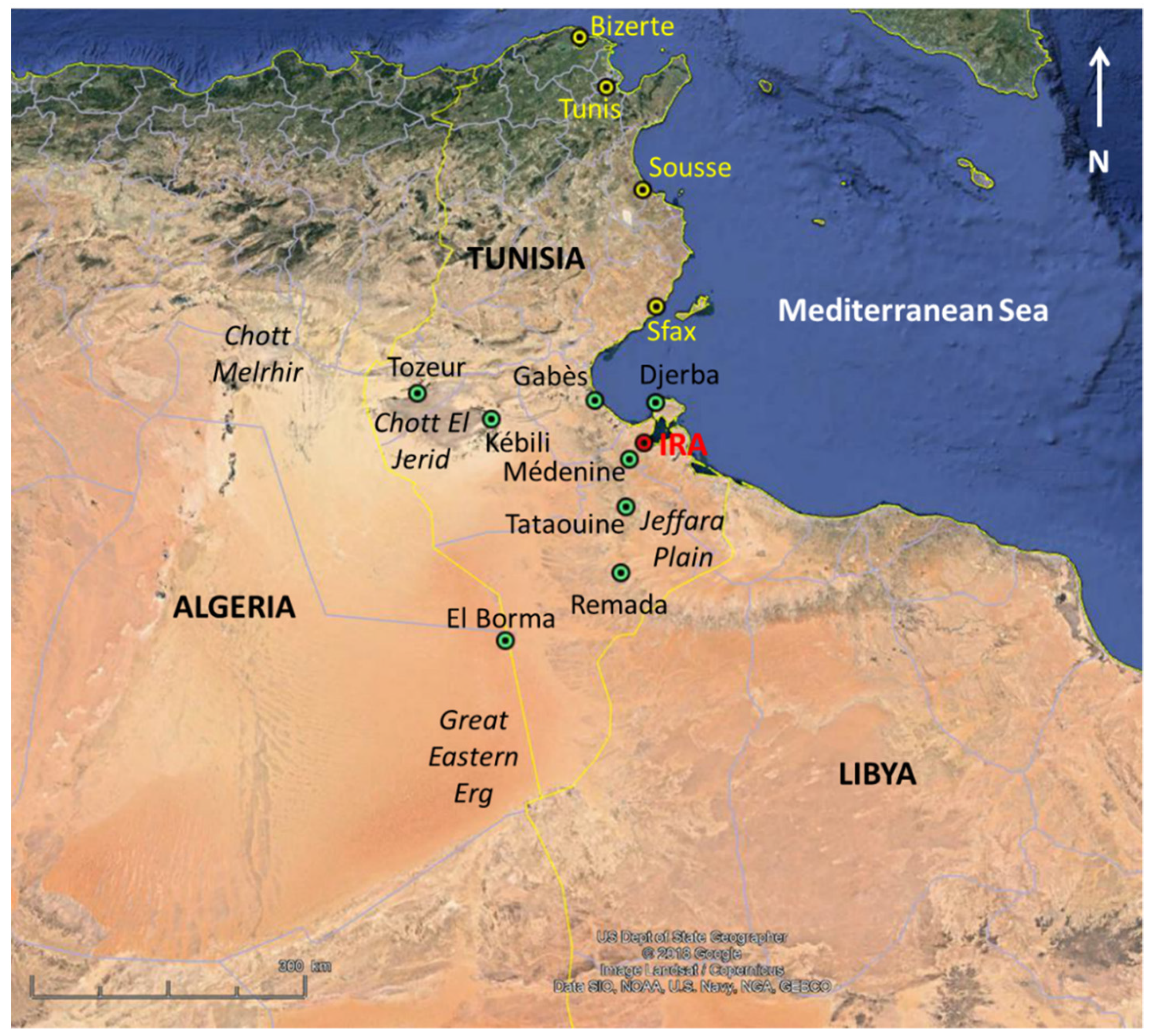
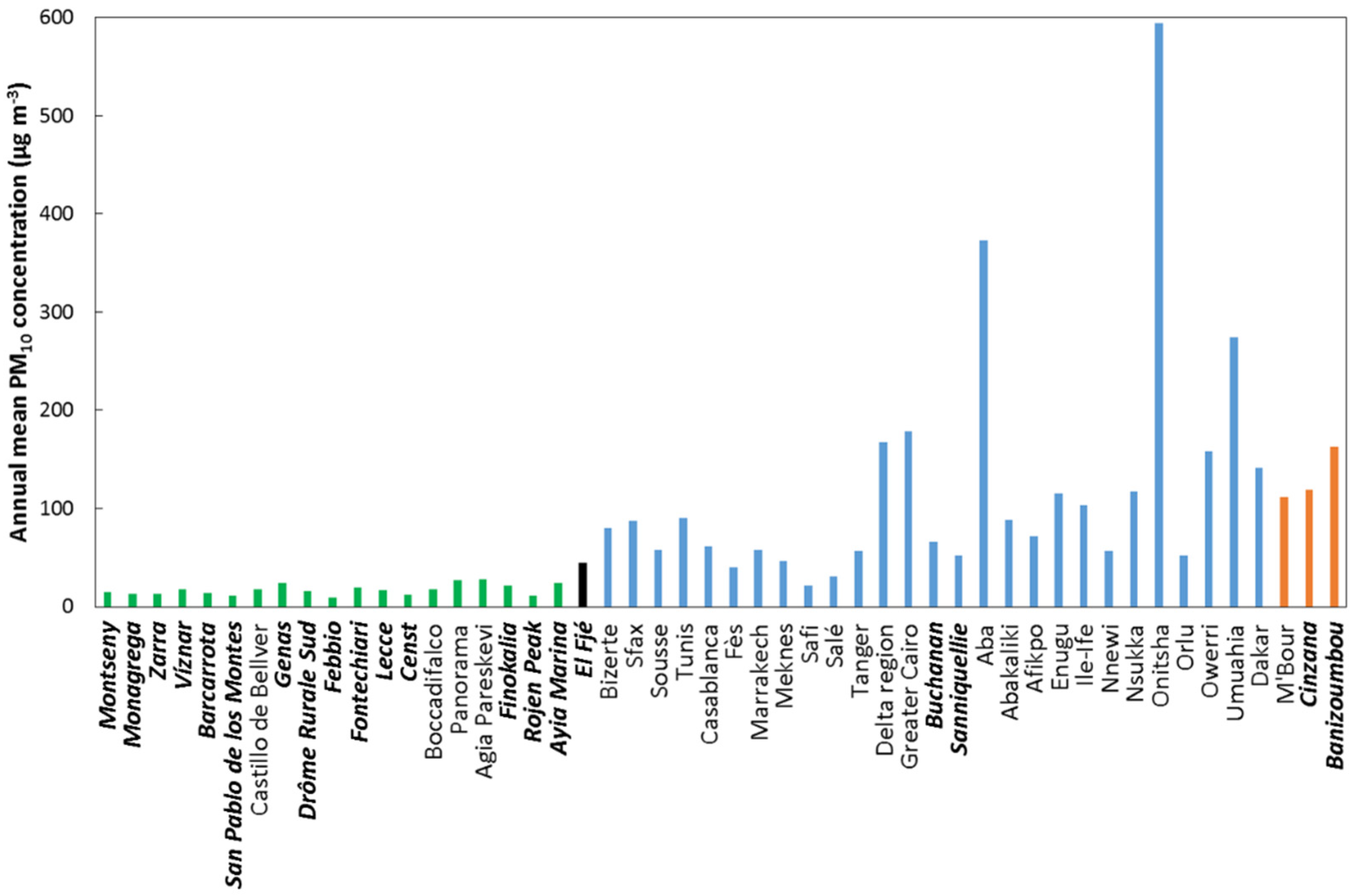
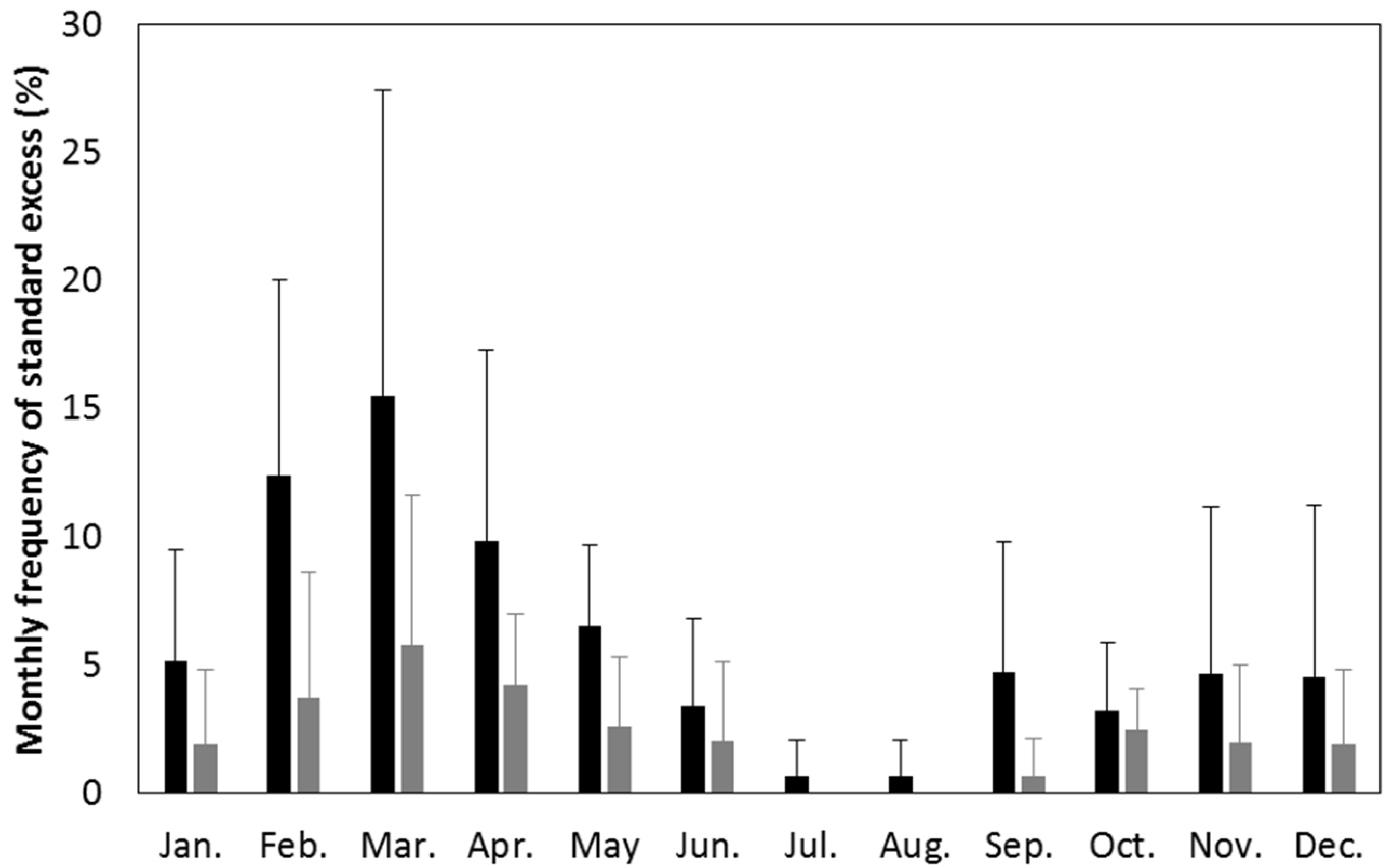


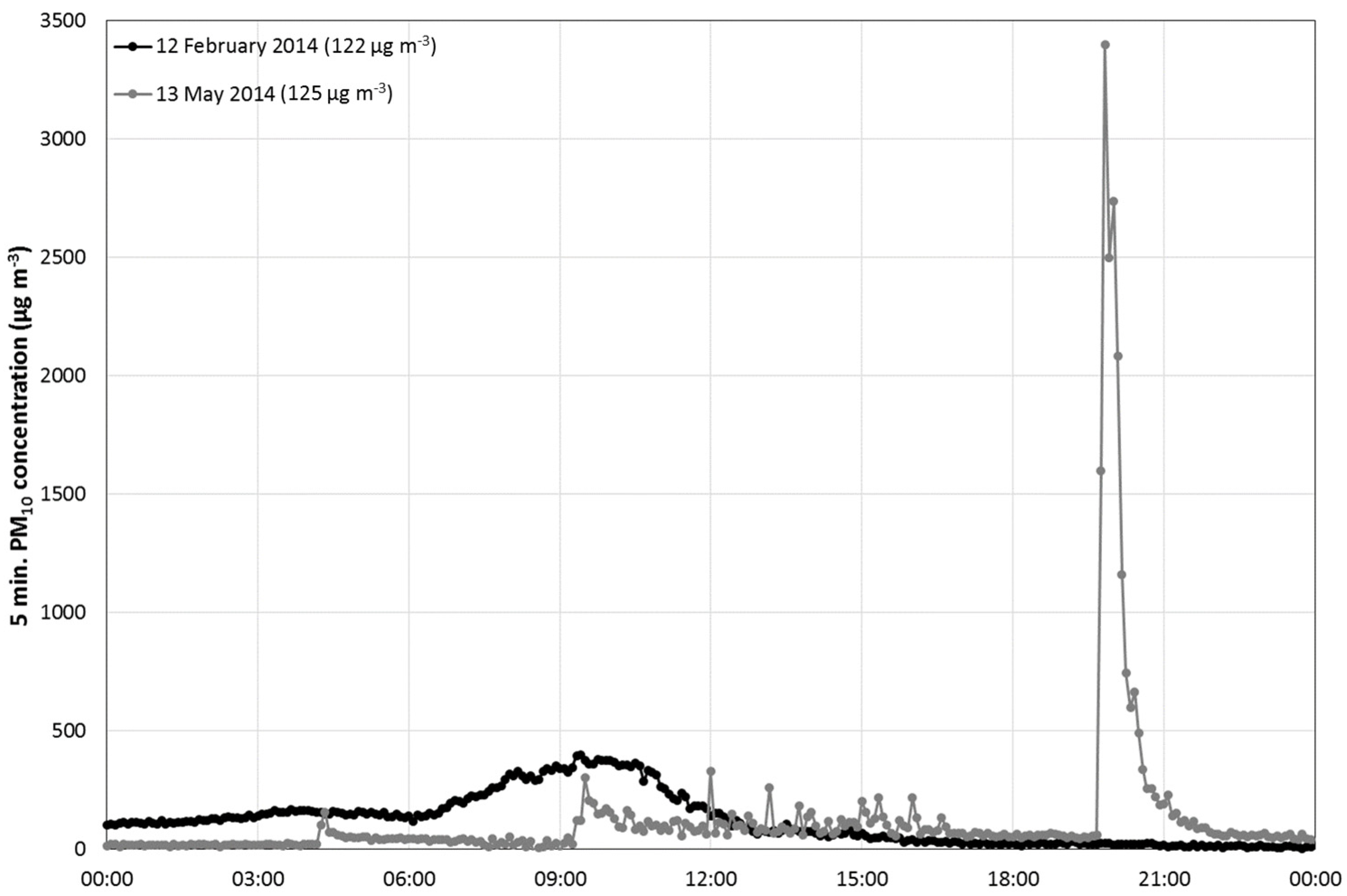
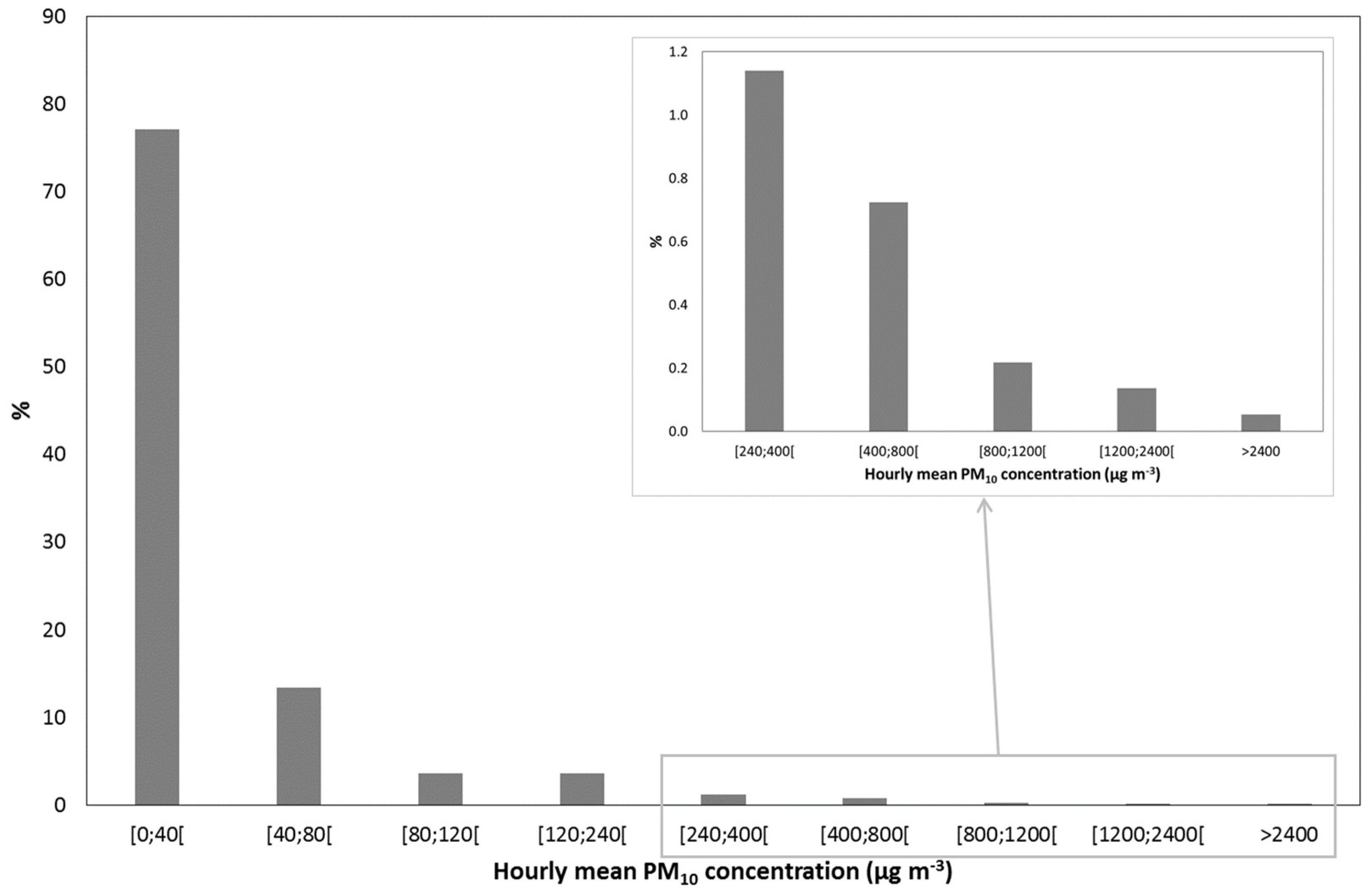
| Type of Average | Authorization of Excess | Limit Value Relative to Health (µg m−3) | Limit Value Relative to Well-Being (µg m−3) |
|---|---|---|---|
| Annual | - | 80 | 40–60 |
| Daily | once a year | 260 | 120 |
| Year. | Annual Mean PM10 Concentrations (µg m−3) |
|---|---|
| 2014 * | 56 |
| 2015 * | 44 |
| 2016 | 51 |
| 2017 | 32 |
| 2018 | 42 |
© 2019 by the authors. Licensee MDPI, Basel, Switzerland. This article is an open access article distributed under the terms and conditions of the Creative Commons Attribution (CC BY) license (http://creativecommons.org/licenses/by/4.0/).
Share and Cite
Bouet, C.; Labiadh, M.T.; Rajot, J.L.; Bergametti, G.; Marticorena, B.; Henry des Tureaux, T.; Ltifi, M.; Sekrafi, S.; Féron, A. Impact of Desert Dust on Air Quality: What is the Meaningfulness of Daily PM Standards in Regions Close to the Sources? The Example of Southern Tunisia. Atmosphere 2019, 10, 452. https://doi.org/10.3390/atmos10080452
Bouet C, Labiadh MT, Rajot JL, Bergametti G, Marticorena B, Henry des Tureaux T, Ltifi M, Sekrafi S, Féron A. Impact of Desert Dust on Air Quality: What is the Meaningfulness of Daily PM Standards in Regions Close to the Sources? The Example of Southern Tunisia. Atmosphere. 2019; 10(8):452. https://doi.org/10.3390/atmos10080452
Chicago/Turabian StyleBouet, Christel, Mohamed Taieb Labiadh, Jean Louis Rajot, Gilles Bergametti, Béatrice Marticorena, Thierry Henry des Tureaux, Mohsen Ltifi, Saâd Sekrafi, and Anaïs Féron. 2019. "Impact of Desert Dust on Air Quality: What is the Meaningfulness of Daily PM Standards in Regions Close to the Sources? The Example of Southern Tunisia" Atmosphere 10, no. 8: 452. https://doi.org/10.3390/atmos10080452





